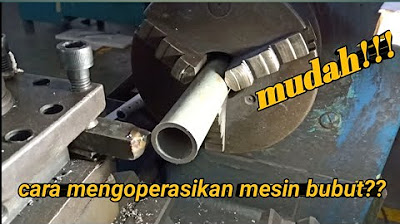Bagian - bagian utama Mesin Bubut
Summary
TLDRThis video tutorial introduces the fundamental components and functions of a conventional lathe machine. It covers key parts such as the headstock, tailstock, carriage, and bed, explaining how each part works to shape cylindrical workpieces. The video highlights the roles of the lead screw, cross feed, and longitudinal feed in ensuring precise cutting operations. The tutorial aims to provide viewers with a clear understanding of lathe machine functionality, ideal for beginners or those looking to enhance their knowledge of machining processes. Future videos will expand on additional tools and techniques used in lathe operations.
Takeaways
- 😀 The lathe machine operates by rotating the workpiece, which is held in place by a chuck, while a cutting tool moves to shape the workpiece.
- 😀 The machine has several key parts: headstock, tailstock, carriage, cross-slide, and tool post, each performing distinct functions.
- 😀 The headstock connects the motor to the lathe and transmits rotation through a system of pulleys and gears, enabling the workpiece to spin.
- 😀 The tailstock supports the opposite end of the workpiece during operations like drilling, ensuring stability and precision.
- 😀 The carriage holds the tool post and moves the cutting tool along the lathe to perform the shaping operations.
- 😀 The cross-slide on the carriage moves the tool horizontally, controlling the diameter of the workpiece being cut.
- 😀 The tool post holds the cutting tool, which can be adjusted to different angles and positions to perform various types of cuts.
- 😀 The teleskop (tailstock support) stabilizes the workpiece during high-speed operations and ensures accurate cuts by preventing vibrations.
- 😀 The lathe's bed provides a rigid support structure for all components, ensuring the machine remains stable during operation.
- 😀 The lead screw and feed rod automate the movement of the carriage, enabling precise control of the cutting tool for both threading and shaping operations.
Q & A
What is the primary function of the headstock in a lathe machine?
-The headstock connects to the motor and transfers rotational power to the lathe machine through a system of gears and a V-belt, enabling the workpiece to rotate.
How does the longitudinal carriage move and what is its purpose?
-The longitudinal carriage moves the workpiece left and right, adjusting the length of the workpiece during the machining process.
What is the role of the cross carriage in the lathe machine?
-The cross carriage moves the tool horizontally, adjusting the diameter of the workpiece during the turning process.
What is the top carriage used for in lathe operations?
-The top carriage is used for specific turning operations, especially when creating tapered parts, allowing for precise shaping of the workpiece.
What does the tailstock do in a lathe machine?
-The tailstock supports the opposite end of the workpiece, helping to stabilize it and prevent movement or wobbling during turning.
How does the telescope function in a lathe machine?
-The telescope is used for supporting the workpiece during operations like drilling. It ensures that the workpiece remains stable and centered during these processes.
What is the purpose of the bed (meja) in the lathe machine?
-The bed provides support for both the carriage and headstock, ensuring that the lathe's components remain aligned and stable during machining.
What is the role of the transport shaft (poros transportir) in the lathe machine?
-The transport shaft helps move the carriage automatically during certain operations, such as threading, to ensure consistent movement and precision.
Why is it important to use a rotating center or tailstock during turning operations?
-Using a rotating center or tailstock ensures that the workpiece remains stable and centered during turning operations, preventing wobbling and ensuring precision.
What is the difference between the longitudinal and cross carriages in terms of movement?
-The longitudinal carriage moves the workpiece left or right to adjust its length, while the cross carriage moves the tool forward or backward to adjust the diameter of the workpiece.
Outlines

Esta sección está disponible solo para usuarios con suscripción. Por favor, mejora tu plan para acceder a esta parte.
Mejorar ahoraMindmap

Esta sección está disponible solo para usuarios con suscripción. Por favor, mejora tu plan para acceder a esta parte.
Mejorar ahoraKeywords

Esta sección está disponible solo para usuarios con suscripción. Por favor, mejora tu plan para acceder a esta parte.
Mejorar ahoraHighlights

Esta sección está disponible solo para usuarios con suscripción. Por favor, mejora tu plan para acceder a esta parte.
Mejorar ahoraTranscripts

Esta sección está disponible solo para usuarios con suscripción. Por favor, mejora tu plan para acceder a esta parte.
Mejorar ahoraVer Más Videos Relacionados

bagian bagian mesin bubut

MENGENAL BAGIAN MESIN BUBUT

Penjelasan Bagian-Bagian dari Mesin Bubut dan Fungsinya

Pembubutan Menggunakan Taper Attachment || Teknik Pemesinan Bubut @Murdiyono

Introduction to the Tool Room Lathe Video

Cara mengoperasikan mesin bubut. (Tehnik dasar)||How to operate a lathe. (Basic technique)
5.0 / 5 (0 votes)
